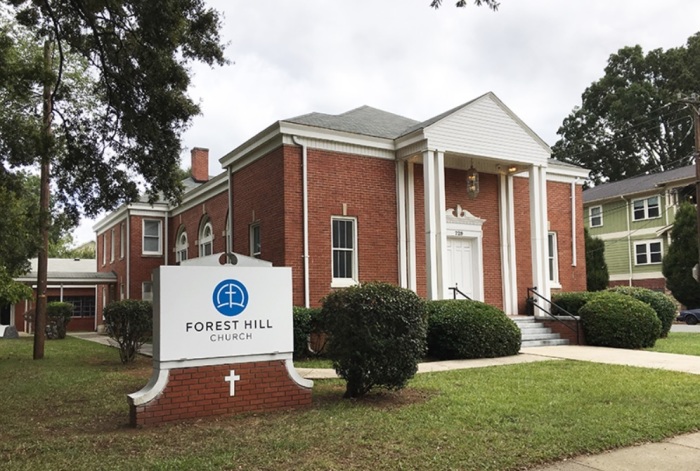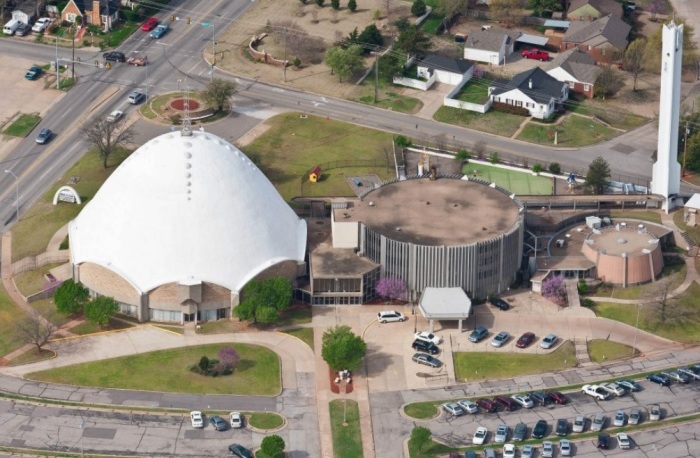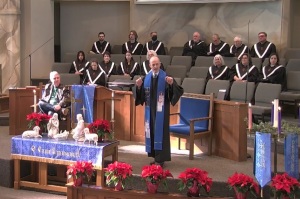Dying churches merging with megachurches a growing trend, some oppose 'drastic change'

In recent years many congregations in the United States have seen their membership numbers drop to the point where they were forced to close down.
Two such examples were Johnston Memorial Presbyterian Church, a Presbyterian Church (USA) congregation, and Ebenezer Associate Reformed Presbyterian Church, both located in Charlotte, North Carolina.
The two congregations experienced decline due to a host of factors, according to Stacey Martin of Forest Hill Church, a multisite church based in Charlotte, in comments to The Christian Post last month.
“Both of these churches had at one time been very reflective of the communities in which they were planted. Over time, however, both dwindling and aging congregations realized that they were no longer effective in reaching or representing the communities around them,” explained Martin.
“Because of gentrification and redevelopment of the areas around these churches, the demographics had changed, and these congregations realized they did not have the ability to be nimble enough to respond to the changes.”
Martin told CP that Forest Hill had connections to the two churches and, as a result, they were invited to purchase the two properties and make them part of their network of campuses.
“Forest Hill was invited in, not only because of the relational connection I previously mentioned, but because of a recognition that our approach to ministry was biblical, effective and unencumbered by some of the tradition and history that many denominations feel,” continued Martin.
“Our nimbleness around organizational growth and fiscal stability gave them confidence about moving forward in partnership with us.”
And so it was that Johnston Memorial Presbyterian became Forest Hill’s NoDa Campus and Ebenezer ARP became Forest Hill’s South Boulevard Campus, becoming two of Forest Hill’s six campuses.
A rising and growing trend

The two Presbyterian congregations becoming part of Forest Hill is not a rare occurrence, but rather is an increasingly sought after solution for small dwindling churches.
Ron Edmondson, CEO of the Leadership Network, an organization that seeks to help provide strategic resources for church leaders, called church mergers “a rising and growing trend.”
“Some 42 percent of multisites come by way of merger. The typical merger is a mainline church in decline merging with an evangelical, often nondenominational church,” Edmondson told CP.
“Across America, nondenominational churches are now 21 percent of all Protestant churches, according to Scott Thumma’s research at the Hartford Institute.”
Warren Bird, vice president of Research at the Evangelical Council for Financial Accountability, co-authored along with Jim Tomberlin the 2012 book Better Together: Making Church Mergers Work, which seeks to help guide congregations considering mergers.
“Mergers are occurring among churches of all sizes and types, and they are happening in urban centers, suburban neighborhoods, and rural communities,” noted the book’s preface.
“Such mergers reflect a growing trend where two local churches at different life stages leverage their common DNA and complementary differences to generate greater synergy for a stronger regional impact.”
Bird and Tomberlin went on to point out that 80 percent of Protestant churches were in decline or stagnant, while of the 20 percent that are growing “many are in desperate need of space.”
“These conditions present a potential win-win for forward-thinking church leaders who believe that ‘we can do better together than separate,’ and it is revitalizing church topography,” they added.
We are not competitors

Doing better together than apart seems to be the theme with the two congregations that joined Forest Hill, as according to statistics provided by Forest Hill, both sites have seen considerable growth following their merging with the multisite church.
When Ebenezer ARP joined Forest Hill in 2015, they had around 25 weekly worshipers. Since then, the number has increased to over 200.
When Johnston Memorial Presbyterian joined Forest Hill last year, they had fewer than a dozen. That has since ballooned into approximately 300 attendees.
As part of the merger process, Forest Hill purchased the properties of both churches, with Martin of Forest Hill telling CP that the Johnston Memorial Presbyterian property, in particular, was much sought after by others.
“For Johnston Memorial Presbyterian, their property was highly-desired among developers in a new, up and coming area near Charlotte’s Uptown,” said Martin.
“But the elders of Johnston Memorial wanted the property to stay missional and to maintain the sacredness and original intent — to reach people for Christ. We consider it an honor that they entrusted Forest Hill with the continuation of that mission and the legacy of their church.”
NoDa Campus Pastor Jason Smith, whose campus was the former Johnston Memorial Presbyterian, said in a statement to CP that he believes when “mergers or acquisitions take place in the Church, we need to see that we are not competitors.”
“We need to see that merging is not failing but instead assigning highest and best use to Kingdom resources. Partnerships like this give us the ability to increase Kingdom effectiveness across all lines of ministry. The possibilities are amazing,” Smith stated.
Rebirth

Liquid Church, a growing nondenominational church based in New Jersey, has absorbed two congregations in recent years, making them into new campuses in its multisite system.
One of the two was St. Paul’s United Church of Christ in Garwood, which held its final services in 2015, with the shrinking congregation voting to merge with Liquid Church.
St. Paul’s UCC was reopened as Liquid’s Garwood campus in 2016 in what the growing evangelical church labeled a “rebirth.”
Mike Leahy, pastor of campuses at Liquid Church, told CP in an interview in early May that conversations with St. Paul about a possible merger began in 2015.
This came after members of the UCC congregation visited the nearby Liquid campus known as Mountainside, which was itself a former nondenominational church that recently merged with Liquid.
“They started coming to the evening service at Mountainside,” recalled Leahy, noting that “they were going through the same process [as the church that became Mountainside] although they weren’t at the same point.”
Leahy explained to CP that while the switch from UCC to Liquid involved a few changes to the worship environment of the campus, he believes they're "committed to the same thing.”
“It’s an invitation to join and be part of what God has already been doing in their congregation, although it’s going to look and sound a little bit different, externally in terms of the music, the environment,” said Leahy.
“We are committed to communicate the truth of God’s Word and try to reach the community and the next generation.”
According to Leahy, there were two important themes when it came to the rebirth process: “honoring the past to be able to reach the future” and “honoring the leadership of the past to build on the spiritual legacy for reaching that next generation.”
“What we want to do is we want to honor those members for the rich spiritual legacy that they have as part of their congregation,” he said.
“Before we launch we have a series of meetings with the congregation as an opportunity to answer questions, to get to know them personally, and for them to have the opportunity to make the decision themselves if they would like to continue or be part of Liquid when it reopens.”
For its part, the Garwood campus has seen considerable growth since joining Liquid. In 2015, when the UCC congregation halted, there were fewer than 50 active members. At present, the campus averages nearly 450 worship attendees a week.
A drastic change

Decisions to merge are not always unanimous, however. In the case of St. Paul’s UCC becoming a campus of Liquid Church, there were those who actively opposed the idea.
Ken Hess, the last pastor of St. Paul’s UCC who presently serves at a church in Pennsylvania, spoke to CP on May 23 about his experiences with his former congregation.
Hess noted that he was critical of the merger, noting that there were theological differences between the liberal mainline denomination and Liquid, as well as concerns over Liquid’s leadership structure.
“[St. Paul’s] was declining in membership and numbers and having a difficult time supporting itself. And so they looked at different options,” recalled Hess.
“I presented them with some options, that I had known other churches that had closed, what they did and some options they could use. They went with a different option than I would have gone with.”
Initially, the congregation rejected the idea of joining Liquid Church, according to Hess. However, when it was brought up again later on, and with the help of a few prominent members of the congregation, the decision to join Liquid was approved.
“They voted to go that direction. It wasn’t a direction that I would have recommended because we come from a different theological perspective on things,” said Hess.
“So I moved on to another church and they wound up going. I shouldn’t say the congregation as a whole did, because basically the congregation dissolved and the assets were given to the Liquid Church.”
Hess explained to CP that some at St. Paul’s stayed with the church as it became a Liquid campus, while others ended up going to other congregations.
“The membership had dwindled to such a low number, that the few that had wanted to go with Liquid Church were the most boisterous and the others sort of just were too tired to fight,” he said.
“I would say out of 25 people, maybe a handful left with Liquid Church. The rest found other UCC churches to attend and sort of just gave up.”
Hess told CP that he has “dealt with small churches and church vitality and trying to revitalize churches” and knows that church mergers are very popular.
However, he added, “it’s usually within the same denomination or least within the same theological field,” labeling the vote to join Liquid as “a drastic change.”
The Context of Resurrection

The trend of church mergers and smaller churches voting to give their properties to growing evangelical congregations is continuing in the country.
One developing example is in Oklahoma, where First Christian Church of Oklahoma City agreed to sell a portion of its property to Crossings Community Church in late April.
The declining FCC of Oklahoma City announced the sale in its May newsletter, with Senior Pastor John Malget writing that he presented this news “in the context of resurrection.”
“This will allow the buildings to be resurrected for the use in which they were intended as a church. It will also allow FCC OKC to receive resurrection as we move forward with the call that God has on us,” he wrote.
“First Christian Church of Oklahoma City is not dead, but is very much alive as we serve our community and help others see the resurrection in their lives.”
Earlier in the year, there was a strong possibility that the church, whose egg-shaped building is on the National Register of Historic Places for its architectural design, was going to be demolished over maintenance issues.
Jennifer Ayotte, spokesperson for Crossings Church, explained in comments emailed to The Christian Post in April that they were “excited about the possibility of a satellite in this location of our city.”
“We will be spending the coming months evaluating this opportunity as we have no plans of demolishing the iconic structure, but rather have it continue in its originally intended use as a church,” said Ayotte.
In an update provided to CP in late May, Ayotte explained that Crossings was planning to hold an informational meeting in the summer regarding next steps.




























